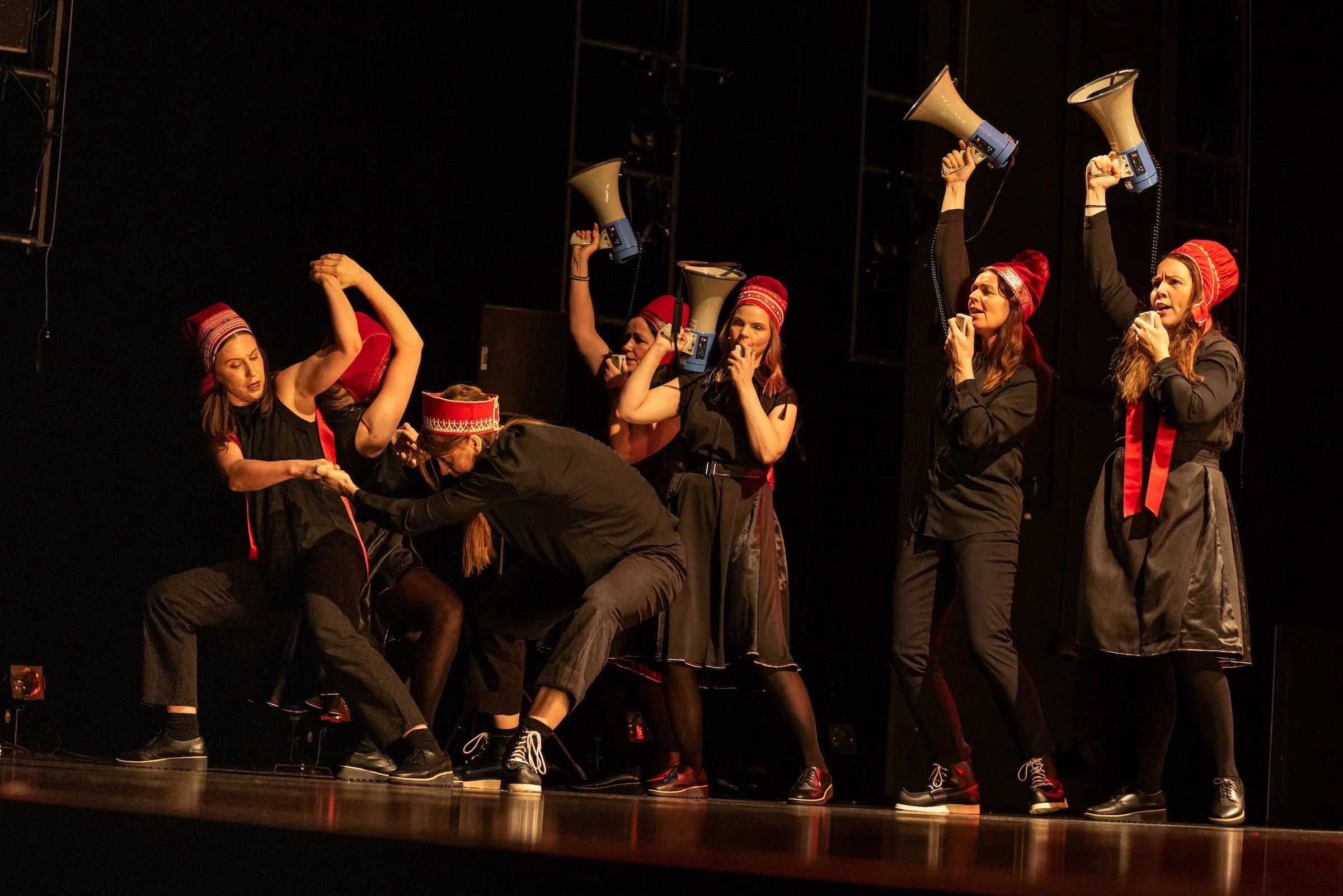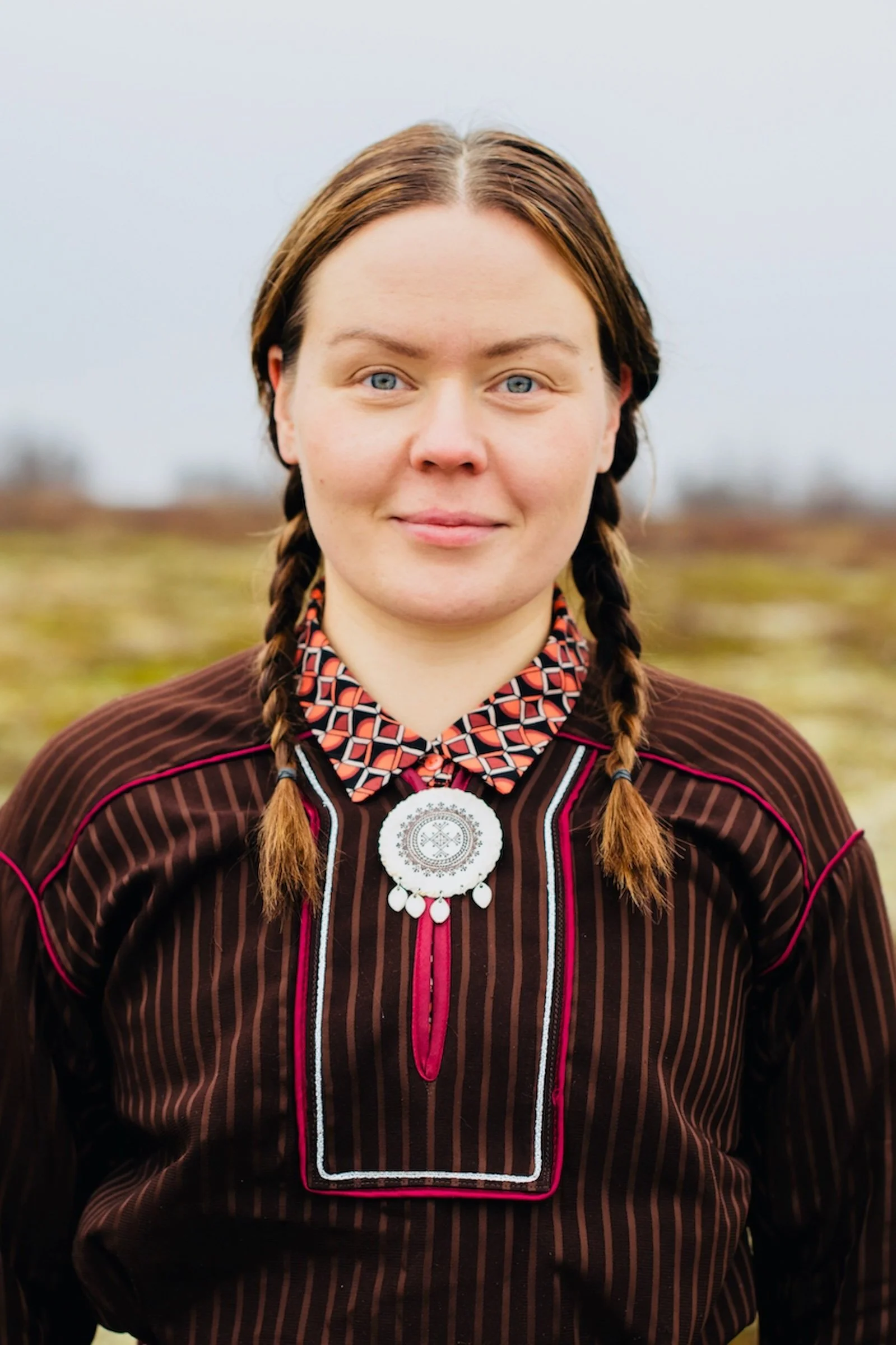Dance artist Elle Sofe Sara draws on Sámiland roots in Vástádus eana – The answer is land
The choreographer who spends her summers reindeer herding with her family creates a piece that integrates joiking, megaphones, and proud red hats
Megaphones meet traditional Sámi headwear in Vástádus eana – The answer is land. Photo by Knut Åserud
DanceHouse and Dancers of Damelahamid present Vástádus eana – The answer is land at the Vancouver Playhouse on February 23 and 24
WHEN STIR REACHES choreographer Elle Sofe Sara in the far northern stretches of Sámiland, daylight is finally returning after an extended night.
“It gets a little bit lighter each day, and I think it was on the 18th of January we started to see the sun here again,” she tells Stir by Zoom from her home in Guovdageaidnu Finnmark, where she grew up. It lies above the Arctic Circle, an incredible 1,600 kilometres north of Oslo. “I was glad to see it for the first time on the horizon. You always look forward to that.”
For the contemporary-dance choreographer, the rhythms of day and night, the seasons and weather patterns, and the tundra and arctic moorland around her are deeply ingrained. That will become clear to audiences who see Vástádus eana – The answer is land, when it reaches the DanceHouse program in the coming week, co-presented with Dancers of Damelahamid.
Her husband, like so many in the traditional home of the Sámi, is a reindeer herder—work that takes Sara to a cabin on ancestral land each summer, as her family migrates with the animals to grazing pastures, a process that takes a week and a half. “When we get there, there’s loads of equipment and fences and corrals—it’s a working place also, but it’s really nice,” she explains. “We always enjoy it a lot. The kids are off from school so we can be there for two months all together.”
Sofe, who holds a Masters in choreography from Oslo National Academy of the Arts and studied at London’s Trinity Laban Conservatoire of Music and Dance, could have settled in a larger city centre to pursue her art form. But early on, she made a conscious decision to move back to her isolated traditional lands to work. She has no regrets.
“I have times in my career where it is very busy, where I travel a lot, and I’ve also been away to make productions, but I feel always that home is a place where I recharge my batteries,” she explains. “Herding—it’s not an easy job. You have to stay awake or it’s very cold or it’s very hot in the huts, and so it’s not ‘Zen mode’, but I really recharge my batteries in that work. I feel it’s very worth it. I don’t know how to say it, but it’s like an investment in my creativity. I feel that it’s very important to me to do that. And I feel very privileged that I can do it—that I have prioritized it.”
Reclaiming cultural practices is something Sara also does in her dance work. For more than 2,000 years, the nomadic Indigenous Sámi lived and worked on northern territory that stretched from Norway to Russia. As in Canada, colonial policies later forced assimilation, stripping them of their traditional culture, via residential schools, language suppression, and religious conversion.
Working as reindeer herders is just one of the ways the Sámi are undoing the erasure. Art is another.
Elle Sofe Sara. Photo by Anne Katja Gaup
One of the most well-known Sámi traditions is joiking—or “yoiking”—a beautiful form of a cappella musical expression that sounds somewhere between singing, yodelling, poetry, and chanting. It can be deeply personal or spiritual, dedicated to a person, an animal, or the landscape. Sara integrates it into the show coming to Vancouver, with composer Frode Fjellheim presenting it here in mesmerizing polyphony.
As for the choreography, don’t expect anything resembling what you might associate with “folk dance” in Vástádus eana – The answer is land, which won the 2022 Norwegian Critics Award.
“The Sámi people are one of the few people in the world that don't have traditional dance,” Sara explains. “It’s very strange, but it’s probably a result of colonization, especially the Christianization. Also the joiking was forbidden—as a sin, or the devil’s work—so it almost disappeared.”
Instead, Sara’s work draws on more everyday Sámi physicality and unspoken rituals, finding movement where past and the present interweave. The show even makes a moving nod to shepherding.
Similarly, the costumes mix the contemporary and ancient. Today’s Sámi people proudly wear a unique style of clothing known as the Gákti, whose distinctive, horn-shaped red headwear appears in Vástádus eana.
“They were banned in Christianity and they have just come back in recent years,” Sara says. “So you feel very strong when you wear that red hat.” Sara pairs them with sleek black costumes that contrast with the brightly adorned sashes and tunics that the Sámi normally wear. The choice was symbolic: it brings to mind mourning and activism, particularly against climate change that is being felt acutely in the world’s Far North. “It’s very hard to stand in a climate crisis, and you feel unrest and sorrow. So I think the black costumes with the red hats come together in this kind of sorrow.”
Another key device that pops up in Vástádus eana is the megaphone. For Sara, it represents the solidarity of movements from Black Lives Matter to #MeToo to Standing Rock, but also the kinship of women: the piece is performed by seven female dancers. The bullhorn is also a device that has been a go-to in Sámi protests in her homeland—used by activists, usually proudly decked out in Gákti, fighting everything from wind farms to rare-earth mines that hinder the rights of the Indigenous people to raise reindeer.
But asked if Sara considers this work political, she explains her approach has more nuance.
“I don’t know that it is political. I’m a very quiet person,” she begins. “For this piece, it’s more like it comes from a place of love. I feel that what I tried to do here is find some sort of calmness between all of us people. It’s not to say that ‘This is mine and this is yours, and here are the borders,’ but more like, ‘There are no borders.’ So maybe I think it’s political with love.”














